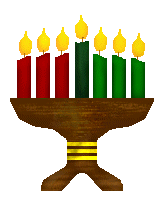
Lighting Kwanzaa Kinara
It's a known fact now that lighting Kinara is very important while celebrants step into the celebration moods of Kwanzaa. Black, Red and Green candles are placed in the candleholder or Kinara. Each of these candles has dissimilar notions.
The first night of Kwanzaa:
The first Kwanzaa night starts with lighting the black candle. It represents the principal of unity (Umoia).
The second night of Kwanzaa:
Relight the black candle first. The utmost left hand side candle which is red is lit on the second night during Kwanzaa. It represents self- determination (kujichagulia).
The third night of Kwanzaa:
Firstly, lit up the previous candles and then the farthermost right hand side candle (green) is lit and it signifies the collective work and accountability (ujima).
The fourth night of Kwanzaa:
Lit up the previous candles once again on the fourth Kwanzaa night then the second candle from the utmost left position (red) is lit. It denotes the principal of cooperative economics (ujamaa).
The fifth night of Kwanzaa:
On this night the second green candle from the farthest right hand side should be lit along with all the previous candles. It represents "purpose" (nia).
The sixth night of Kwanzaa:
Relight the previous candles which were lit earlier as well. The remaining red candle which is placed at the third position from the utmost left hand side should be lit to represent creativity (kuumba).
The seventh night of Kwanzaa:
On seventh night, the black candle is lit, then the utmost red, the farthest right one, then the second red, then second green, then the last red candle and lastly the green candle. This represents faith (imani).
Discuss the principle of the day. By now everyone of your family should be able to explain what principle means to them. That needs to be practiced always. Call out "Harambee!" for seven times and close the candle lighting ceremony.
 Friendship Day
Friendship Day Good Morning
Good Morning